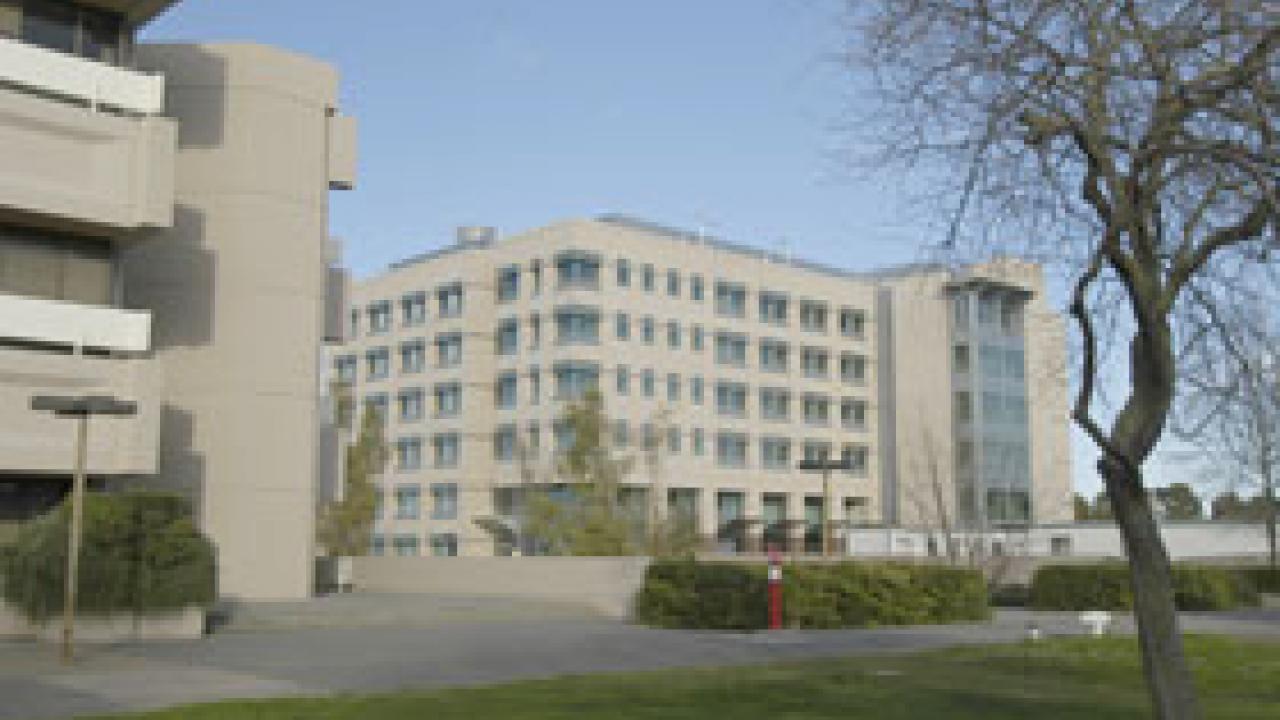Food and health. Livestock diseases. And gene sequencing.
These are examples of the research explored every day in the Health Sciences District on campus along the southwestern portion of campus. With more buildings on the way, the district will serve as a cornerstone of the campus for the next century, expanding UC Davis' efforts in human medicine, veterinary medicine, and the environmental and agricultural sciences.
The 2003 Long-Range Development Plan, which is spurring more than $1 billion in campus development based on the university's academic mission, is shaping the bricks-and-mortar growth in the Health Sciences District near Highway 113 and Interstate 80.
"With a focus on scholars and students, the Health Sciences District will continue to experience an intense period of growth in the next several years," said Bob Segar, assistant vice chancellor for campus planning. "These state-of-the-art facilities in veterinary medicine, the medical sciences and genomics will link together different fields of human knowledge in the life sciences."
One new kid on the block is the $98 million Genome and Biomedical Sciences Facility, due to open this summer. The six-story facility, located north of Tupper Hall, will house the UC Davis Genome Center and other research and administrative units. With an interdisciplinary focus, faculty will explore issues in DNA sequencing, protein structure, metabolic profiling and population genetics, among others.
Neal Van Alfen, dean of the College of Agricultural and Environmental Sciences, said the new genomics building will play a vital role on campus and beyond.
"What we eat is known to affect our health," said Van Alfen, "but we are beginning to understand that there is a much more complex interaction between the components of food and the health of individuals than was previously known. Genomics is the key to understanding this interaction -- thus helping us all live in better health."
The Genome Center will further catalyze the development of genomics programs across the campus and connect fundamental life science research programs with applied research in agriculture, veterinary medicine and medicine.
Phyllis Wise, dean of the Division of Biological Sciences, described the current era as a "revolutionary time" in the biological sciences.
"Our knowledge of the genome changes the way we approach questions, how we design studies, how we analyze results and how we apply the data to the practice of medicine, to the application to agriculture, to the conservation of the environment, and to the teaching of the life sciences," she said.
Wise explained that the new building will "allow us to amplify and spread discoveries to the rest of the campus and the national and international community in a more efficient way than if they were dispersed individually in many different places where they might not know of the work of others."
Many of new faculty hired for the center will be split between research interests in plants, animals and microbes, with several whose work involves multiple groups of organisms. The new hires will include both "wet-lab" scientists and bioinformatics researchers who do most of their work on computers. The nearby Genome Launch Facility also provides space for offices and laboratories.
Another development is the long-awaited consolidation of veterinary medicine facilities and programs in the Health Sciences District.
Bennie Osburn, dean of the School of Veterinary Medicine, said his program will benefit from the consolidation by bringing faculty members together for the first time in 34 years and by having classes for students all in one area instead of in the 10 or so buildings separated by almost a mile.
"The arrival of the facilities will provide for a much improved teaching environment for students as they will be close to clinical case material used in their instruction," Osburn said.
The benefit will be that veterinarian students will have instructional facilities in one place -- in a new quad just north of the Vet Med Teaching Hospital.
Recently completed veterinary projects include the Veterinary Medicine Instructional Lecture Hall, a 90-seat facility designed to support surgical training programs at the school. Other projects finished include both large and small animal holding facilities, another lecture hall, and a laboratory facility.
One project now in its design phase is a 125,000-square-foot teaching, research and clinical facility, to be located northwest of the campus's Veterinary Medical Teaching Hospital. Referred to as Veterinary Medicine 3A during the planning process, this facility will house teaching laboratories, faculty research laboratories, research support services, academic offices, clinical services and administrative offices. The building is planned for completion in 2005. A companion classroom building is on a similar time frame.
Vet Med 3A is a key component of a $354 million long-range facilities plan for the veterinary school, designed to restore the school's full accreditation status and prepare for enrollment and academic growth anticipated for the next decade.
Planning is just beginning on Vet Med 3B, which will consolidate all of the Vet Med faculty in the Health Sciences District, vacating Haring Hall for other campus uses.
Other projects currently in construction include health sciences infrastructure, Tupper Hall renovations and the USDA Western Human Nutrition Facility. The latter is planned as a 49,000-square-foot, two-story building slated for opening in 2005. It will house research laboratories and administrative offices, and is one of six such USDA sites in the nation.
Segar says a sense of unity is central to the new progress in the district. "With the new combination of buildings and surroundings, the district will feel like part of the campus while also having its own district identity."
Landscape and circulation improvements are planned to tie the different projects together in a cohesive environment.
The Long-Range Development Plan will help UC Davis accommodate more students in the years ahead and thus meet its obligations to the state. Estimates call for an average on-campus student population of 30,000 and a total enrollment of 32,000 by 2015, as well as an increase in faculty and staff to support those students.
The LRDP and accompanying documents are available at http://www.ormp.ucdavis.edu/environreview/lrdp.html.
